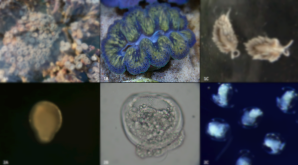
Coral reefs are coastal marine ecosystems that present one of the most expressive levels of biodiversity. Such environments are conspicuous given that their carbon production is mainly related to photosynthetic dinoflagellates called zooxanthellae. These organisms are found in an endosymbiotic association with several marine phyla, especially corals. However, coral reefs are fragile environments that have been affected by climate change, specifically by thermal increase and ocean acidification. These events disrupt the symbiotic relationship, resulting in the death of the hosts in a phenomenon called “coral bleaching”.
While the scientific community has already produced a significant amount of data regarding this symbiotic relationship, most of this information is related to the adult stage of the host. Very few information is available regarding this relationship while the hosts are still in their larval development, which is a critical moment for population dispersal and recruitment.
The project ReSimbio is active since 2012 and its primary objective is to better understand the symbiotic relationship between different clades of zooxanthellae and larvae of Anthozoa (corals), Bivalvia (giant clams) and Gastropoda (sea slugs). All of these hosts present larval stages that acquire zooxanthellae before becoming adults. The project has three main objectives and three peripheral objectives:
Main objectives:
- Determine the moment in which the symbiosis berween zooxanthellae and host larvae is established. Molecular biology and gene expression techniques will be employed.
- Verify the content of fatty acids translocated from symbiont to host larva, through analytical chemistry techniques.
- Test the tolerance to acidification; larvae containing zooxanthellae will be placed in acidified media and the zooxanthellae evasion will be monitored.
Peripheral objectives:
- Map the structure of symbiosis-specific genes expressed by different zooxanthellae clades.
- The establishment of practical guidelines for the culture of symbiotic sea slugs.
- Determine the content of fatty acids produced by zooxanthellae in the tissues of giant clams.
A total of 13 researchers are involved in the project led by Prof. Paulo Sumida and his PhD student Miguel Mies. Six of them belong to the Oceanographic Institute of the University of São Paulo (IO-USP), two of the Biosciences Institute of the University of São Paulo (IB-USP), two of the Chemistry Institute of the University of São Paulo (IQ-USP) and three of the Federal University of Rio de Janeiro (UFRJ) and the Coral Vivo Project.